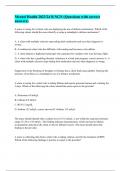Essay
Unit 22 - Aspects of Civil Liability for Business - Task 2 (P4 and M2)
- Vak
- Instelling
This is the second task of Unit 22 - Aspects of Civil Liability for Business, in which consists of P4 and M2. To achieve P4, you need to define the tort of ‘Nuisance’ and explain the requirements of liability in the law of Nuisance, applying it to real life case examples. For M2, you need to ap...
[Meer zien]












